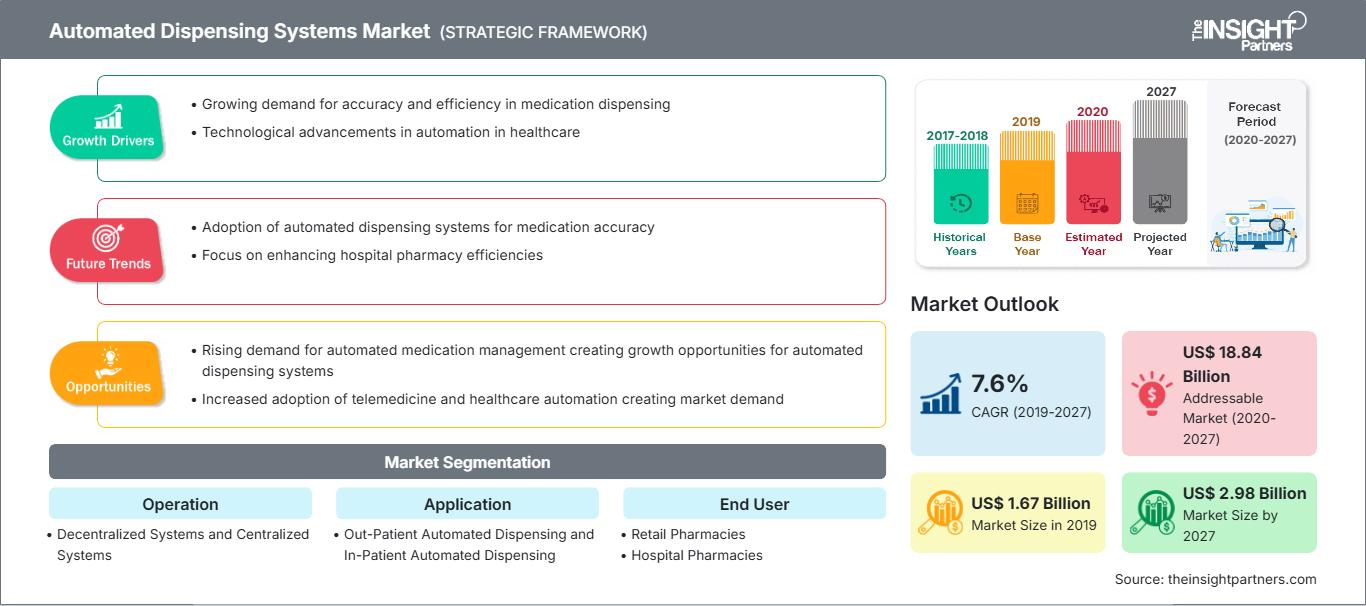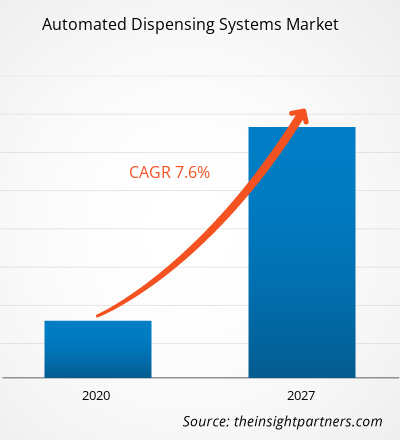Le marché des systèmes de distribution automatisés devrait atteindre 2 980,38 millions de dollars américains d'ici 2027, contre 1 665,78 millions de dollars américains en 2019 ; sa croissance devrait atteindre un TCAC de 7,6 % entre 2020 et 2027.
Les systèmes de distribution automatisés, également appelés armoires à médicaments automatisées, sont des dispositifs électroniques de stockage et de distribution de médicaments, principalement utilisés dans les établissements de santé. Ces systèmes facilitent le suivi et le contrôle de la distribution des médicaments ; ils sont sécurisés par des mots de passe authentifiés et des données biométriques pour le contrôle des stocks et la sécurité des médicaments contre le vol. Ces systèmes ont été mis en avant comme l'un des instruments potentiels pour améliorer l'efficacité opérationnelle et la sécurité des patients. De plus, ils sont désormais largement utilisés dans les cliniques et les maisons de retraite, entre autres. Les systèmes de distribution automatisés contribuent à transformer les hôpitaux en établissements plus sûrs, plus efficaces et plus performants.
Le marché mondial des systèmes de distribution automatisés est stimulé par des facteurs tels que l'augmentation des erreurs de médication et la croissance de la population gériatrique. Cependant, les problèmes liés aux systèmes de distribution automatisés, tels que les erreurs de programmation, les pannes d'équipement et autres, peuvent freiner la croissance du marché. De plus, les marchés émergents créent des opportunités de croissance pour les acteurs du marché.
Vous bénéficierez d’une personnalisation sur n’importe quel rapport - gratuitement - y compris des parties de ce rapport, ou une analyse au niveau du pays, un pack de données Excel, ainsi que de profiter d’offres exceptionnelles et de réductions pour les start-ups et les universités
Marché des systèmes de distribution automatisés: Perspectives stratégiques

- Obtenez les principales tendances clés du marché de ce rapport.Cet échantillon GRATUIT comprendra une analyse de données, allant des tendances du marché aux estimations et prévisions.
Aperçu du marché
Augmentation des erreurs médicamenteuses
Une distribution irrationnelle, inappropriée et inefficace de médicaments peut entraîner de graves erreurs médicamenteuses pouvant nuire aux patients. Parmi les erreurs médicamenteuses les plus courantes, on trouve la mauvaise distribution, la mauvaise quantité, la mauvaise concentration et l'omission d'articles. Environ 75 % des erreurs médicamenteuses sont causées par des distractions, car les professionnels de santé sont occupés à de multiples tâches, comme l'examen des patients, les échanges avec les consultants, les discussions avec les familles des patients et les conversations avec les professionnels de l'assurance.
Chaque année, la Food and Drug Administration (FDA) des États-Unis reçoit plus de 100 000 signalements d'erreurs médicamenteuses. De plus, selon l'étude « Medication Errors » publiée dans StatPearls en juin 2020, environ 7 000 à 9 000 personnes meurent chaque année des suites d'une erreur médicamenteuse aux États-Unis. Français De même, selon les estimations publiées dans l'étude « Prévalence et fardeau économique des erreurs de médication au sein du NHS en Angleterre » en 2018, environ 237 millions d'erreurs de médication se produisent chaque année au sein du NHS et les effets indésirables évitables des médicaments (EIM) entraînent des centaines de décès.
Informations basées sur l'exploitation
Sur la base de l'exploitation, le marché des systèmes de distribution automatisés est segmenté en systèmes décentralisés et systèmes centralisés. Le segment des systèmes centralisés détenait une part de marché plus importante en 2019 en raison de facteurs tels que le besoin croissant de réduire les coûts, de garantir la disponibilité des médicaments et de moderniser l'allocation des ressources. De plus, les systèmes décentralisés devraient enregistrer un TCAC plus élevé sur le marché au cours de la période de prévision.
Informations basées sur l'application
Sur la base de l'application, le marché des systèmes de distribution automatisés est segmenté en distribution automatisée pour les patients hospitalisés et en distribution automatisée pour les patients ambulatoires. Le segment de la distribution automatisée pour patients hospitalisés détenait une part de marché plus importante en 2019 ; toutefois, la distribution automatisée pour patients ambulatoires devrait enregistrer un TCAC plus élevé au cours de la période de prévision.
Informations basées sur l'utilisateur final
Selon l'utilisateur final, le marché des systèmes de distribution automatisée est segmenté en pharmacies hospitalières, pharmacies de détail et autres. Le segment des pharmacies hospitalières détenait la plus grande part de marché en 2019 ; toutefois, le segment des pharmacies de détail devrait enregistrer le TCAC le plus élevé du marché au cours de la période de prévision.
Le lancement et l'approbation de produits sont les stratégies couramment adoptées par les entreprises pour étendre leur présence mondiale et leurs portefeuilles de produits ; ces stratégies les aident à répondre à la demande croissante des consommateurs. La collaboration est l'une des principales stratégies adoptées par les acteurs du marché des systèmes de distribution automatisée pour élargir leur clientèle à l'échelle mondiale, ce qui leur permet également de maintenir leur marque à l'échelle mondiale.
Aperçu régional du marché des systèmes de distribution automatisés
Les tendances régionales et les facteurs influençant le marché des systèmes de distribution automatisés tout au long de la période de prévision ont été analysés en détail par les analystes de The Insight Partners. Cette section aborde également les segments de marché et la répartition géographique de ce marché en Amérique du Nord, en Europe, en Asie-Pacifique, au Moyen-Orient et en Afrique, ainsi qu'en Amérique du Sud et en Amérique centrale.
Portée du rapport sur le marché des systèmes de distribution automatisés
| Attribut de rapport | Détails |
|---|---|
| Taille du marché en 2019 | US$ 1.67 Billion |
| Taille du marché par 2027 | US$ 2.98 Billion |
| TCAC mondial (2019 - 2027) | 7.6% |
| Données historiques | 2017-2018 |
| Période de prévision | 2020-2027 |
| Segments couverts |
By Exploitation
|
| Régions et pays couverts | Amérique du Nord
|
| Leaders du marché et profils d'entreprises clés |
|
Densité des acteurs du marché des systèmes de distribution automatisés : comprendre son impact sur la dynamique des entreprises
Le marché des systèmes de distribution automatisés connaît une croissance rapide, portée par une demande croissante des utilisateurs finaux, due à des facteurs tels que l'évolution des préférences des consommateurs, les avancées technologiques et une meilleure connaissance des avantages du produit. Face à cette demande croissante, les entreprises élargissent leur offre, innovent pour répondre aux besoins des consommateurs et capitalisent sur les nouvelles tendances, ce qui alimente la croissance du marché.

- Obtenez le Marché des systèmes de distribution automatisés Aperçu des principaux acteurs clés
- Analyse historique (2 ans), année de base, prévision (7 ans) avec TCAC
- Analyse PEST et SWOT
- Taille du marché Valeur / Volume - Mondial, Régional, Pays
- Industrie et paysage concurrentiel
- Ensemble de données Excel
Rapports récents
Témoignages
Raison d'acheter
- Prise de décision éclairée
- Compréhension de la dynamique du marché
- Analyse concurrentielle
- Connaissances clients
- Prévisions de marché
- Atténuation des risques
- Planification stratégique
- Justification des investissements
- Identification des marchés émergents
- Amélioration des stratégies marketing
- Amélioration de l'efficacité opérationnelle
- Alignement sur les tendances réglementaires






















 Obtenez un échantillon gratuit pour - Marché des systèmes de distribution automatisés
Obtenez un échantillon gratuit pour - Marché des systèmes de distribution automatisés